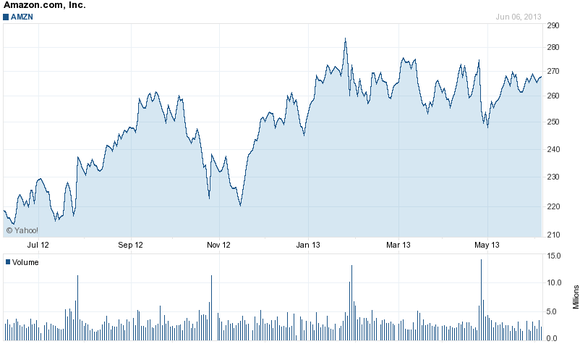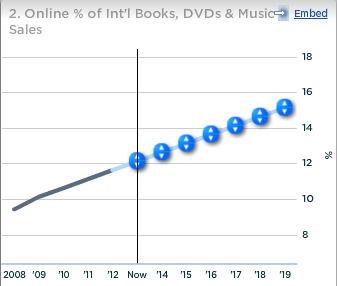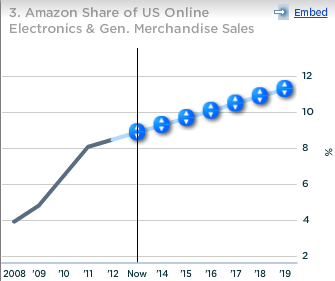The global leader in the online retail industry, Amazon.com, Inc. (NASDAQ:AMZN) has only risen 7.31% so far in 2013, not even half of the return provided by the Dow Jones Industrial Average so far this year.
Amazon.com, Inc. (NASDAQ:AMZN) is a leading online retailer offering a broad array of items, with a prominent presence both domestically and internationally. Based on market capitalization, Amazon is valued at $122.55 billion. However, the profitability of the company’s business model has been brought into question, as the TTM profit margin is currently -0.14%.
With the stock trading within $15 of all time highs, at current prices is Amazon.com, Inc. (NASDAQ:AMZN) a solid investment in the world of tomorrow, or should investors wait for a more reasonable valuation to be stapled to this innovative giant?

Strengths:
Institutional Vote of Confidence:
67% of shares outstanding are held by institutional investors, representing over $80 billion in investment, displaying the confidence some of largest investors in the world have in the company and its future.
Explosive Revenue Growth:
In 2003 Amazon reported revenue of $5.26 billion; in 2012, the company announced revenue of $61.09 billion, representing year over year annual growth of 31.32%, an explosive trend which is anticipated to sustain into the future, with projections placing 2017 revenue at $162.69 billion. This growth has been a result of the rapid adoption of the Amazon.com, Inc. (NASDAQ:AMZN) platform and the growing popularity of online retail both internationally and in the US.

Leading Market Position:
Amazon is the leader in the online retail industry both domestically and internationally, possessing top market share positions, and with this comes a greater level of dominance and control over its industry.
Brand Value & Loyalty:
Amazon’s brand value is estimated to be $28.66 billion, and the level of brand loyalty most customers display is
valuable.
Innovative Business Model:
The company possesses virtually unlimited online shelf space, and can offer customers a vast and diverse selection of products through an effective search and retrieval interface, and the shopping experience is personalized by Amazon recommending products based on past purchases and a wide array of reviews that are offered on the site, giving the company a distinct advantage over traditional brick and mortar retail stores.
Free Cash Flow: In 2013, Amazon.com, Inc. (NASDAQ:AMZN) is projected to generate $4.9 billion in free cash flow, representing the financial strength and security the company possesses.
Net Cash Position: Amazon’s $10 billion debt load is outweighed by its $11 billion position of cash and cash equivalents, resulting in a net cash position of $1.1 billion, or $2.40 per share, a minor financial strength of the company.
Weaknesses:
Lack of Dividend:
At no time in the company’s history has Amazon paid out a dividend, and the company has expressed no plans of doing so in the future, a major downside for long-term investors.
High Valuation: At the moment, Amazon carries a price to book ratio of 14.53, a price to sales ratio of 2.01, and a price to earnings ratio that is currently negative, all of which indicate a company trading with an extremely high valuation.
Opportunities:
Continuation of Shift to Online Retail Platforms: In 2011, only roughly 7% of total US retail sales were estimated to be e-commerce transactions, totaling $202 billion; however, Forrester Research projects this figure rising to 9% by 2016, totaling $327 billion. Internationally, as of the end of 2011, the use of the Internet as a purchasing tool only possessed a penetration rate of 33%, compared to the 78% penetration rate in the United States, demonstrating incredible potential for e-commerce platforms.




Increase in Market Share:
Amazon.com, Inc. (NASDAQ:AMZN)’s market share of both the international and United States online retail markets has increased substantially over the past years, and is anticipated to continue to gain ground into the future, presenting opportunity for the company to fuel revenue growth.









